Bloggers use a huge range of strategies for content marketing. There are hundreds of techniques used by thousands of bloggers to produce millions of articles. How do we all do it? And what’s working?
We started asking these questions 10 years ago and we immediately knew that the only way to find answers was to ask bloggers directly in a survey. The Annual Blogger Survey was born.
We created the questionnaire and started reaching out, knowing we’d need a minimum of 1000 bloggers to respond. The insights were excellent so we did it again the next year, and the next year, and the next…
Welcome to the 10th Edition of the Annual Blogger Survey. You may already know, this is a big, ungated research piece filled with trends, charts and inputs from experts. We keep updating this same URL because “digital ink is never dry.”
We have a few new blogging statistics this year:
- How are bloggers using AI?
- How does experience correlate with blogging strategies?
We’ll also update the statistics and trends we’ve been asking from the beginning:
- How long does it take to write a blog post?
- How long is the typical blog post?
- How is traffic to blogs changing over time?
- Are bloggers publishing more or less often than before?
- Which formats are driving results?
You find answers to these questions and many many more. In the final section, we’ll show what top bloggers do differently, so you can score your own strategy against what’s working for others.
Find this interesting? We welcome you to use any of these charts or insights in your own content, social streams and meetings. Let’s jump in…
Blogging Effectiveness and Challenges
We’ll start by reporting on the overall effectiveness of blogging. We ask each of the respondents to report on their success by choosing from one of four options. In 2023, one in four bloggers reported “strong results.” This hasn’t changed much over the years.
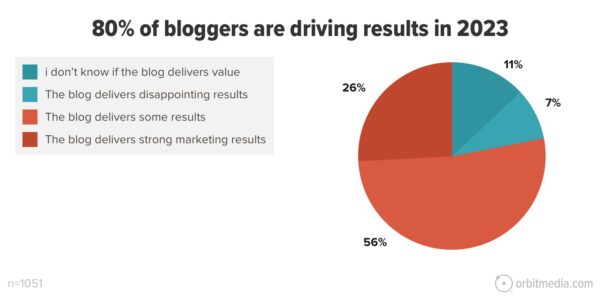
Now we have our benchmark as we look at the rest of the data. Throughout the rest of this report, we’ll show which approaches to blogging correlate with “strong results.”
Of course, the definition of “results” varies from blogger to blogger, so we asked respondents to tell us what success means to them. The responses are typical content marketing goals: website traffic, lead generation, brand awareness and email list growth. Fewer than 10% of respondents use ad revenue as a success metric.
Next we’ll look at the challenges faced by bloggers. Year after year, the top answers are finding time and attracting visitors. Half of all bloggers struggle to find time and to attract visitors.
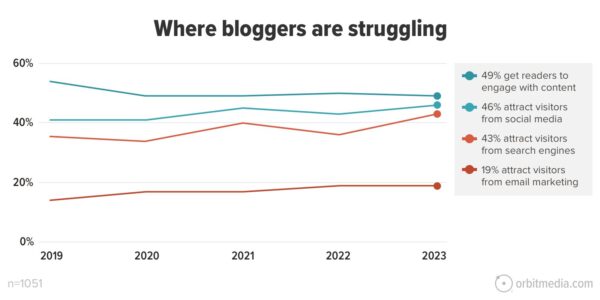
 |
Ann Handley, MarketingProfs“Maybe because our focus should be on creating must-read blogs (newsletters, emails, posts, and the rest!), rather than worrying about visitors. I never worry about attracting visitors. I focus on creating the best content I possibly can — content that could ONLY come from me. When we obsess more over the content itself and less over the “visitor,” the more successful we’ll be. Said another way — let go of attracting visitors; lean into delighting readers. Counter-intuitive… but true.” |
Because time is the biggest challenge for bloggers, we’ll next answer the question: how long does it take to write a blog post? According to averages from the 1051 bloggers who responded to this year’s survey, the average blog post takes 3 hours and 51 minutes to write.
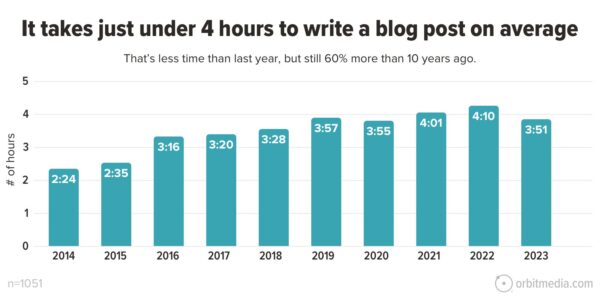
Bloggers are spending less time per post than last year, but it’s still much more time per post than in years past. Bloggers spend 60% more time per blog post than they did 10 years ago.
 |
Ann Handley, MarketingProfs“Well, this chart warms the cockles of my heart. Time invested doesn’t always magically equal “effectiveness,” of course. But it does suggest that content creators are seeing the value of creating more substantive pieces that truly meet the needs of their subscribers and perhaps include elements that take time to include (visuals, influencer quotes, data, contextual stories, and so on). It also suggests that writers are using AI tools not as cut-and-paste content microwaves. Instead, if they ARE using them, it suggests that AI is likely part of the process… not the final product.“ |
Does more time make a difference? Yes. Using the benchmark we set above, we see the correlation between time and results. Bloggers who spend more time are more likely to report success. A third of all bloggers who spend 6+ hours on a typical article report “strong results.”
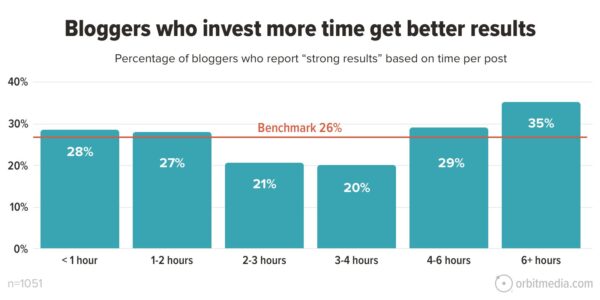
The question of time raises the question of efficiency and tools. So we asked bloggers a question about AI.
 |
John Jantsch, author of Duct Tape Marketing“More time – more results. There certainly should be a correlation, but time isn’t causation – time usually equates to better quality, deeper examples, better graphics, and more resources, and that’s the key driver. Now, keep an eye on this metric because this is an area where AI may have the greatest impact. Not in writing better but in shortening the time it takes for research, expansive ideas, and, at some point, graphics.” |
 |
Kathryn Strachan, CopyHouse“As someone who owns a content marketing agency, I’m not surprised that it takes longer to create high quality content. When you factor in the time to create detailed outlines, interview subject matter experts and thoroughly proof the content this takes time. AI-generated content is the perfect example of how speed doesn’t equal quality. ChatGPT can generate content in seconds but this content lacks substance, is factually incorrect and doesn’t resonate with audiences — all things that take time. After all, Rome wasn’t built in a day. |
The question of time raises the question of efficiency and tools. So we asked bloggers a question about AI.
The use of AI in Blogging
Of course, 2023 is the year that most of us got access to generative AI, a powerful tool for bloggers. The opportunities for content marketing and AI seem to be endless and many bloggers are in research mode. Our own framework for using AI in content marketing has been our most popular webinar ever.
But how are bloggers using AI? We gave respondents many options to let us know how they use it, from the early steps of generating ideas to the final steps of creating promotional social posts.
Bloggers have embraced AI at an incredible rate. 65% of bloggers use AI to varying degrees. The most common use case is generating ideas (43%). The least popular use case is writing complete articles (just 3%).
AI helps bloggers get a head start,
but very few are using it to replace themselves as writers.
Here is the breakdown of AI use across tasks, from the beginning to the end of the blogging process:
- 43% use AI to generate ideas
- 29% use AI to write headlines
- 28% use AI to write outlines
- 21% use AI to write first drafts
- 3% use AI to write complete drafts
- 22% use AI to suggest edits
- 6% use AI to create visuals
- 9% use AI to write promotional emails
- 17% use AI to write promotional social posts
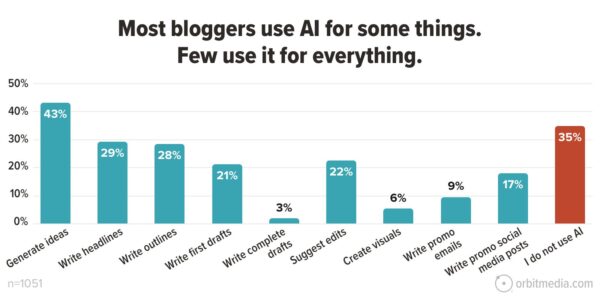
 |
Wil Reynolds, Seer Interactive“For the 35% of the people who aren’t using it, what made them arrive at the decision that ChatGPT isn’t going to be helpful to them? There have to be a lot of interesting assumptions and maybe some serious realities too.” |
We looked for correlations between the use of AI and other responses. We found very few. For now at least, we can report that bloggers who use AI are not more successful than other bloggers. But it’s early. It’s a time for experimentation.
Bloggers who use AI are slightly more likely to be SEOs and to use Analytics. Those were some of the few blogging and AI correlations we found.
Blog post length and frequency
Why are bloggers spending so much more time on posts than in years past? Maybe it’s because their posts are longer. The average blog post length is 1427 words long. That’s the average of the ranges of all of the responses. That’s 77% more words per post than 10 years ago.
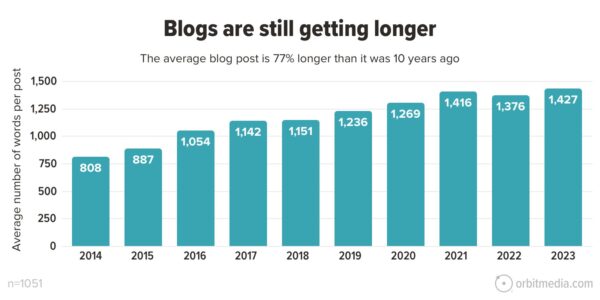
Not all bloggers write long form content. Most bloggers publish articles in the 500-1500 word range. But a small percentage of bloggers go big. Just 3% of blogs regularly publish 2000+ word articles. This blog is one of them.
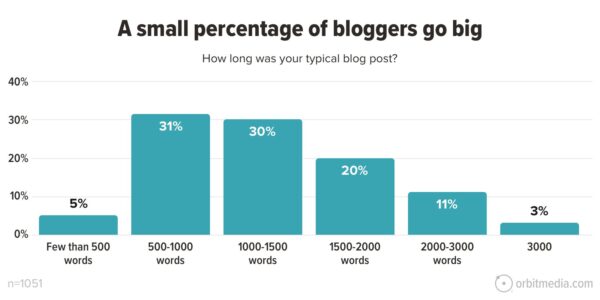
There’s a strong connection between article length and the likelihood of success. The longer the typical blog post, the more likely the blogger is to report “strong results.” Year after year, this is one of the strongest correlations in the study.
 |
Mark Schaefer, author of Belonging to the Brand“One factor driving this trend is the increasing importance of thought leadership. It’s really hard to compete on SEO and depend on search traffic. More attention is focused on earning your own audience through content that demonstrates authority. Authoritative content must be well-researched, unique, in-depth, and comprehensive.” |
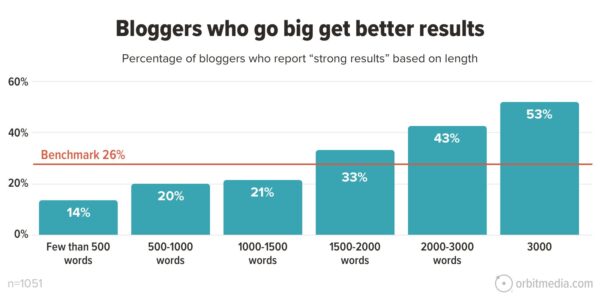
Another major difference among bloggers is publishing frequency. Some bloggers hit the publish button much more often than others. I personally know daily bloggers and quarterly bloggers. We asked the question, how often do bloggers publish? About half of all bloggers publish weekly or several times per month. One in 10 bloggers has no regular cadence.
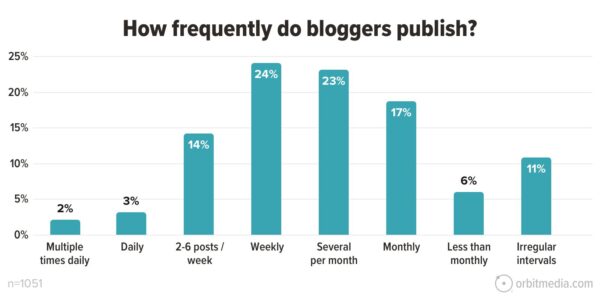
Again, greater efforts correlate with greater rewards. The bloggers who publish the most are most likely to report “strong results.”
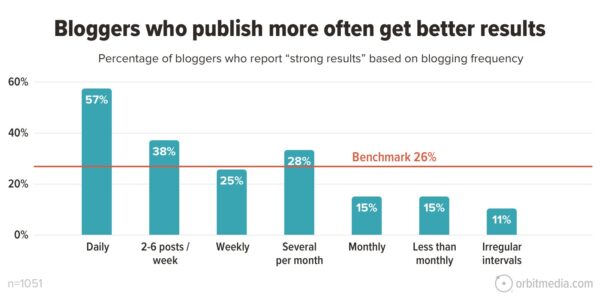
 |
Michael Brenner, Marketing Insider Group“This data warms my heart because it shows what we’ve known for so long: consistency wins in content marketing (and life too btw!). And the fact that fewer bloggers are publishing daily or more than a few times a week, shows us that there is still a clear way to win in any industry: publish great content, as often as you can, as regularly as you can.” |
Of course, no one in the dataset is publishing 3000+ word articles every day. We checked. Long form content and high-frequency are mutually exclusive content strategies.
The data shows a steady decline in publishing frequency. Year after year, we see fewer bloggers publish more than weekly, while more bloggers publish less than weekly. Together with the other trends, it suggests a professionalization of blogging. Blogging is a serious and time consuming job, where quality is prioritized over quantity.
Blogging formats, visuals and video
There are many formats involved in blogging. The most popular is the how-to post. 76% of bloggers publish educational content. Most bloggers publish lists. News and trends are also popular formats, despite the inherent challenges of a news-based content strategy.
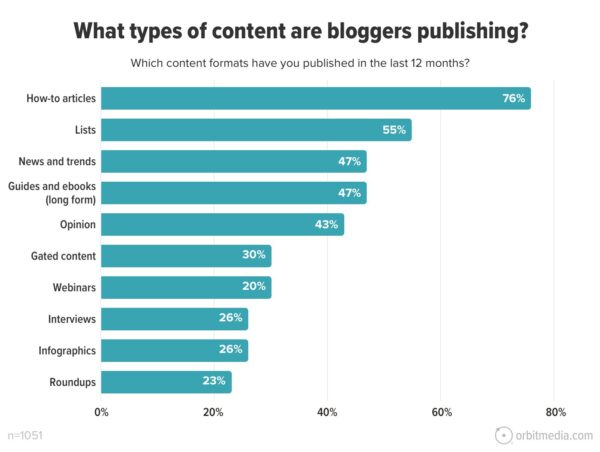
The popularity of blog formats hasn’t changed over time with one exception: interviews and roundups have become less popular. These are the collaborative formats of influencer marketing. They may be out of style, but they are still effective, as well see next.
Which content formats are the most effective? Gated content and long-form guides get the best results. Together, they can directly impact email list growth, which is a common goal for bloggers in the survey.
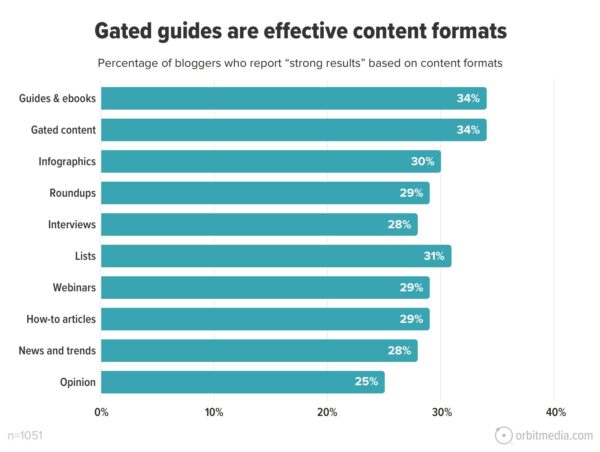
 |
Justin Rondeau, Invisible PPC“I’ve been saying for ages that gated content is still a critical tool in the marketer’s tool belt and now I’ve got data to prove it. There’s been a lot of hype in the past about removing forms, un-gating all content, and most recently by Hermozi to “give until it hurts!” While this is a great sentiment, this philosophy generally works for people who have large amounts of cash to offer the loss in leads and sales previously driven by gated content. It has been and will continue to be my belief that if you’re creating content that’s valuable you should set the terms to access it. So gate away fellow content marketers 🙂“ |
Separately, we asked bloggers what elements they include within a typical blog post. Almost all bloggers add images to their articles. But only half of respondents add supportive data and statistics. This seems low considering the question about original research, later in the report. One in four bloggers uses video, which is a trending format as we’ll need shortly. We also see audio in the dataset, which we assume to be the podcasters.
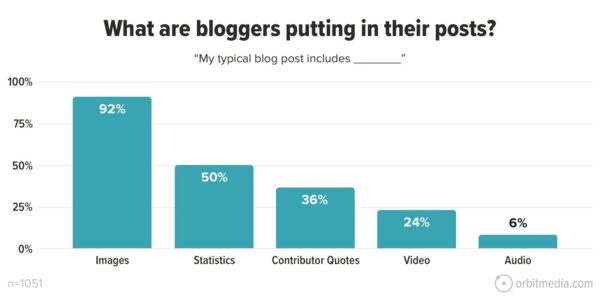
There are connections between formats and performance. The harder to produce formats, video and audio, correlate with “strong results.” This reinforces the theme that greater effort leads to greater rewards. If nothing else, these are formats that differentiate a blog from its content competitors.
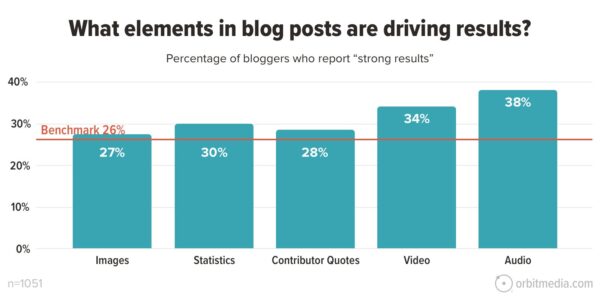
 |
Jenn Dudley, Dante32“I’m not surprised to see the low percentage for audio, although I expect that number to grow as the technology for creating and embedding audio continues to improve. For podcasters, creating blog posts with an embedded audio player for each episode is a straightforward way of extending the reach of content already created. However there’s tons of potential for audio content beyond posting podcast episodes, especially in the B2B space, including creating audio companion tracks for survey reports, using audio testimonials alongside case studies, and embedding soundbites within a blog post, as an alternative to a pull quote. We’ve really just scratched the surface of what’s possible for audio content.” |
Video is a far more popular format today than it was 10 years ago. The popularity of video has doubled since 2014, possibly because that’s when bloggers discovered the smartphone cameras in their pockets. That was the year that smartphone US market penetration passed 50%, and Apple released the iPhone 6, the best selling smartphone of all time. Also, Instagram had recently started supporting video. The video boom was on.
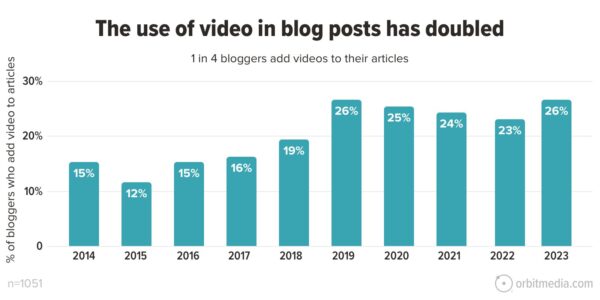
 |
Tony Gnau, T60 | Healthcare Video Production“Video is great, but don’t just add video to a post for the sake of adding video. We always encourage our customers to have a healthcare video production strategy, but it’s good advice for any industry. There needs to be a plan for the post, the video, and how the two complement one another. That’s when good things happen.“ |
Some bloggers add lots of pictures to their content. Others, not so much. The majority of bloggers use 1-3 visuals. But a tiny percentage of us add a lot of images. 2% of bloggers add 10+ images to a typical blog post.
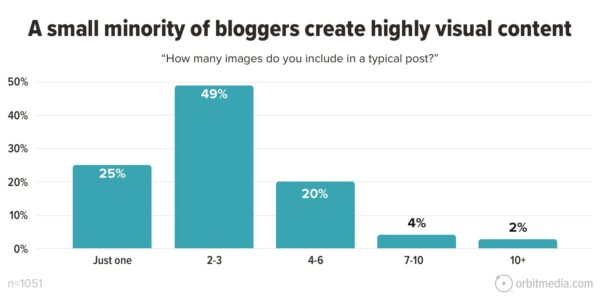
That may sound high, but on this blog, the average post has 17 images, mostly charts and screenshots. There are 33 images in this post, not including the faces of our expert contributors. It’s a whole lot of blogging statistics charts. Shout out to Jantzen! We appreciate you!
This statistic also correlates with performance. Again, more content means more success. Bloggers who add many visuals and embedded videos are far more likely to report success. The internet is a visual place and some bloggers embrace this. Some of the most popular services (YouTube, Netflix, Instagram, Amazon Prime, Facebook) on the internet are focused on serving up visual content.
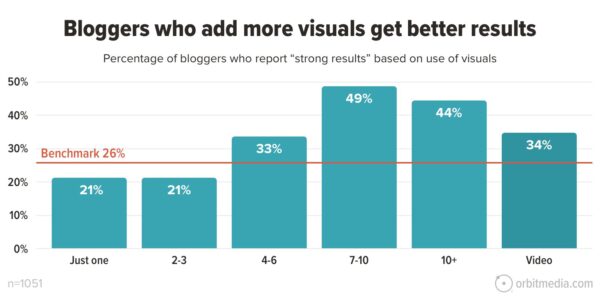
 |
Jodi Harris, Content Marketing Institute“Visuals help drive key messages home and elevate the reader’s experience. By developing a consistent look for your brand’s visuals, your content becomes more memorable and distinctive – critical for standing apart from your competition in a crowded space.“ |
We ask the question about research separately. Having discovered the power of original research through our own content (e.g. this report), we wanted to learn how many other bloggers were conducting research. Each year, more bloggers are conducting original research.
Almost half of bloggers told us they do original research. That number seems high. Maybe they’re publishing comparative reviews or informal polls.
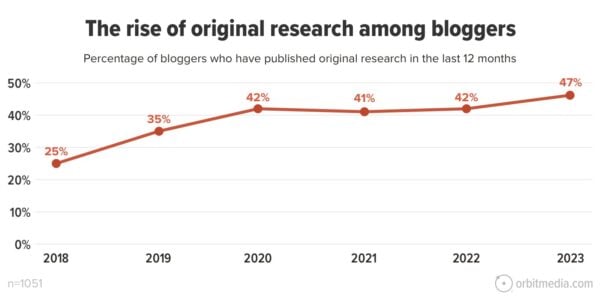
The Editing Process and Updating Old Content
Some bloggers edit their own work, or have another informal process for editing a post by “showing it to a person or two.” Other content programs have rigorous workflows with one or more editors.
Over the last ten years, we’ve seen more bloggers getting serious about editing. Nearly 3x more bloggers work with an editor now than in 2014. This is more evidence that blogging is a more rigorous activity today. It has become a more serious profession with more established best practices.
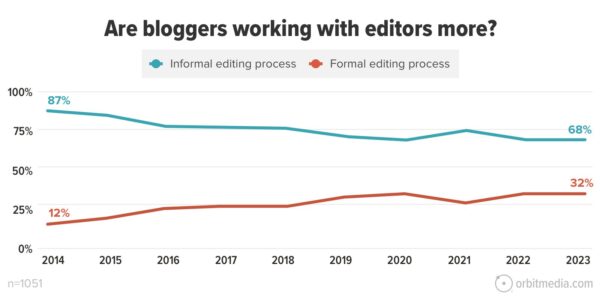
Working with an editor pays off. Of course, there are many successful bloggers who edit their own work. And we saw earlier that 22% are using AI for editing help. But the data shows that bloggers who use a more formal process for edits are more likely to report “strong results.” Editors are making a difference.
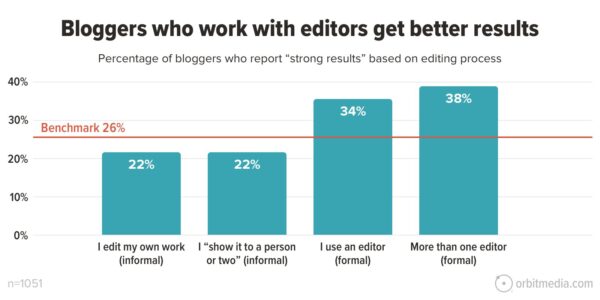
 |
John Doherty, Editor Ninja“The fact that more bloggers are using editors than before is great for the blogging industry. As content marketing has become ubiquitous and AI has ushered in a world where anyone can create a lot of ok content very quickly, the content that will rise to the top is content that has had one or more humans taking a lot of time to massage it and make it stand out above the rest. We also know from a 2017 study of UK online buyers that 59 percent of surveyed buyers reported that bad grammar and spelling mistakes would stop them from making a purchase, fearing that the company couldn’t be trusted to provide quality, professional service, so if bloggers care about business results and not just traffic, they need to leverage editors.“ |
Some bloggers go back and update older content. Others do not. But each year, we see a greater percentage of bloggers who do return to old posts to freshen things up. And it pays off. Bloggers who update old content are twice as likely to report success. When we looked more closely at the data, we see that many of these bloggers are SEOs. Few of these bloggers focus on news.
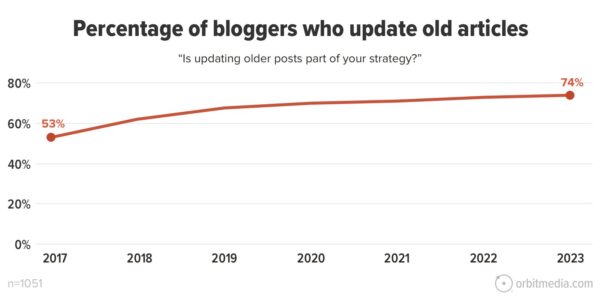
How bloggers drive traffic and measure results
Eventually all bloggers discover, the best content doesn’t win, the best promoted content wins. So next we’ll examine how bloggers promote their content and drive traffic. The 10-year trend shows what’s changed and what stayed the same.
Almost all bloggers promote the content on social media. This hasn’t changed and probably never will. It’s fast, easy and free. SEO and email marketing have become much more popular over the last 10 years. Paid promotion and influencer collaboration became more popular for a time, but have since declined.
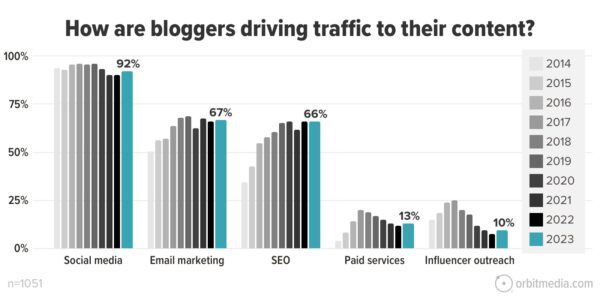
To see the relative changes of each promotion channel, we’ll plot them from the same starting point. It clearly shows the flat (social) the rising (SEO and social) and the ebb and flow (paid and influencer collaboration).
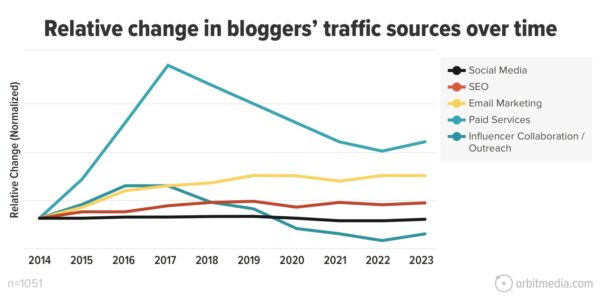
As with every other blogging statistic, we looked for correlations. Here are the connections between promotion and performance. As before, the least common strategies are the most effective. Bloggers who use paid promotion and influencer outreach are the most likely to report success. But it seems that working with influencers was more reliably successful in years past.
Driving traffic from social media is getting more difficult for a simple reason that many social media marketers have noticed for years.
 |
Michael Stelzner, Social Media Examiner“Every major social platform is deprioritizing links to external sites. On top of this, AI will soon be taking away even more traffic. This creates a serious challenge for content creators who want eyeballs to their written work. The day has come. If we want organic exposure from social media, we need to publish our written content there.“ |
It’s a strategic decision with big implications. If you publish directly on the social network, you won’t get the traffic but you may get 10x more visibility to your content. LinkedIn Newsletters are the prime example. Our LI newsletter gets roughly 50x the reach of our email newsletter. So, “don’t build on rented land” …unless it’s effective.
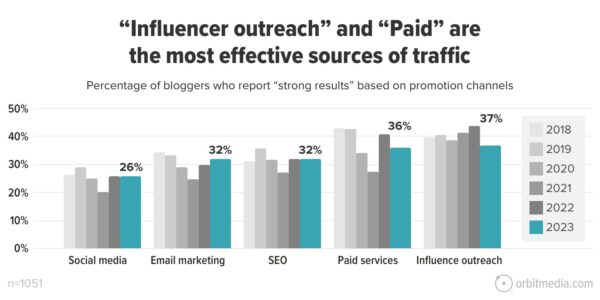
Some bloggers are highly focused on SEO, others not so much. Bloggers who pay more attention to keywords more often, are more likely to report success. This is no surprise. Organic search is often a durable source of traffic, unlike social media and email marketing. Bloggers with even a few big SEO wins can drive a lot of traffic and brand visibility.
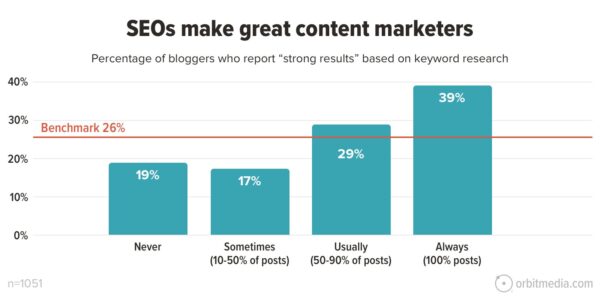
This next statistic makes another strong case for consistency. Bloggers who collaborate with influencers more often are more likely to report success. Involving influencers and subject matter experts in everything (with contributor quotes, interviews and roundups) has a dramatic impact on the likelihood of success.
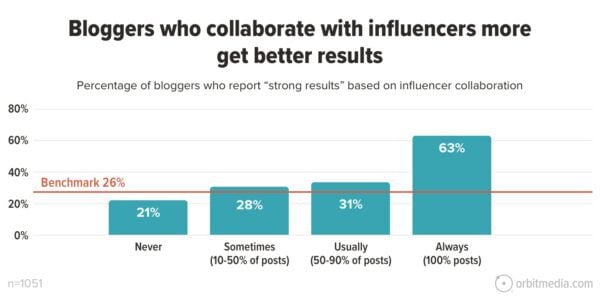
Now that we’ve addressed creation and promotion, we come to the third component in content marketing, measurement. We’re pleased to report that bloggers are using analytics more than ever. Nearly a third of bloggers check the performance of everything they publish.
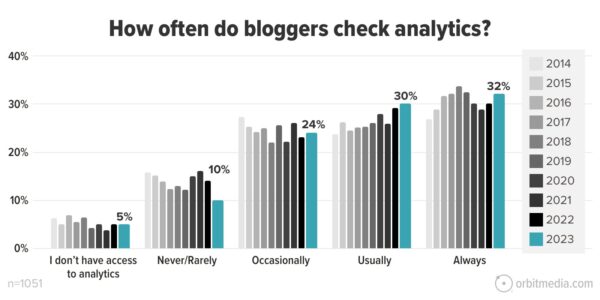
There’s an important subtlety here in the survey question. It spells “analytics” with a small ‘a’ so we’re talking about any type of analytics, including social media metrics. There are many ways to measure content performance.
When we spell it with a big ‘A’ we’re talking about Google Analytics 4 (GA4). There’s an interesting connection between blogger experience and use of analytics. More experienced bloggers are more likely to use analytics tools. The very junior bloggers don’t typically measure results. This AI-generated heatmap shows a clear connection.
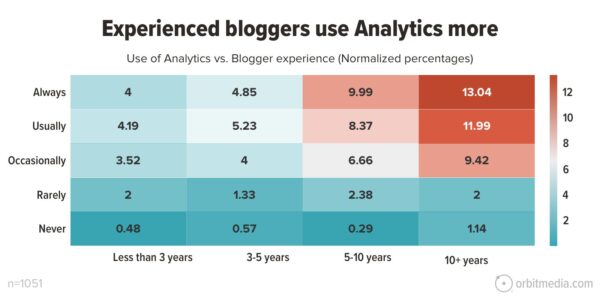
Like that little chart? Here’s how to get ChatGPT to draw heatmaps for you.
 |
Peter Caputa IV, Databox“I’m not surprised to see that more marketers are monitoring metrics for their individual blog posts. Whenever we look at data for a company’s blog, we see that a large portion of traffic comes from a small number of blog posts. The problem for most bloggers is that it’s nearly impossible to predict which ones will end up being those main traffic drivers. So, when it happens, it’s important to take advantage of it and spend extra time making that content better, promoting it, building links to it, etc. Also, traffic to individual blog posts changes over time, usually in the negative direction as other companies publish similar articles or spend time optimizing ones they’ve already published. By paying attention to traffic and conversion changes in real-time, marketers can adapt their editorial calendar, and prioritize content updates and link building alongside new content.“ |
Analytics also correlates with results. No surprise. A blogger that doesn’t know what worked can’t iterate and improve. Without analytics, bloggers have to rely on anecdotes. They have no defense when bad ideas come in from clients and bosses. They’re less likely to win at the bottom of the funnel because bottom of funnel metrics are less visible to them.
Data drives content strategy.
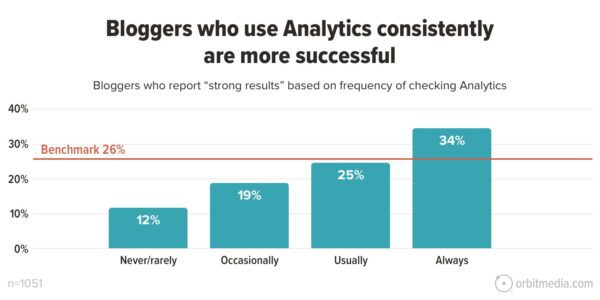
What do top bloggers do differently?
Now we can take these blogging statistics and combine them into one chart that shows which blogging strategies are most likely to drive results. Together, they make a useful scorecard for evaluating your own content strategy.
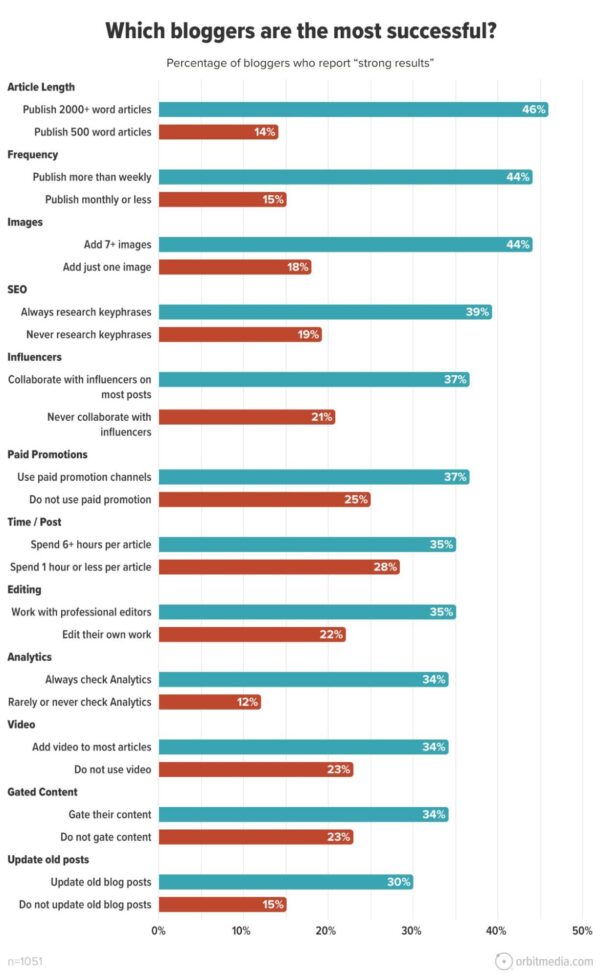
How many of these describe your approach to blogging?
Partly for fun, I’ll close this year’s blogging survey by writing it up like a little scorecard. Of course, it’s not possible for a single blogger to combine all 12 of these, but every blogger should check at least a few.
- 0-3 You employ so few of the high-performing strategies, you’re not likely to drive a lot of brand awareness. Get serious about fishing …or cut bait. But then again, you may still find success if your sales team uses your content to close deals.
- 4-6 You have an active content program. If you’re publishing consistently and measuring results, you may be ready to evolve. Consider stopping one format or topic so you can double down on another. Experiment then invest.
- 7-9 You are among the top bloggers in terms of effective strategies, without question. Assuming your targeting is accurate and your marketing goals align with business objectives, you are destined for greatness. Keep going!
Let’s ask a veteran content pro to score her own content strategy.
 |
Zontee Hou, Convince and Convert“We definitely do 7 of these consistently at Convince & Convert, which speaks to the discipline and dedication of our editorial team. Ultimately, I think that setting your team up for success is about developing a strong process and having a checklist for contributors to your content. Furthermore, it’s important that you think about your blog posts as living content on the internet. Reviewing, updating, linking, and retiring existing content on a regular basis makes sure you’ll get the most out of your top performers and improve your low performers on a consistent basis. That takes discipline and constancy, but it also allows your team to learn and improve all the time.“ |
And finally, we’ll close by summarizing everything we’ve learned about effective content marketing, from research and from experience. It sounds like this:
Consistently produce in-depth, highly visual content,
including original research, in collaboration with influencers.
Align your content keyphrases when possible and update old posts.
Gratitude
First, a big thanks to the 1,051 bloggers who took the time to respond to the survey over 10 years. By far, the biggest challenge of this annual project is data collection. We use many strategies but it always comes down to a lot of one-to-one messages to bloggers on social media. We know it’s no fun to be the target of direct outreach. We sincerely appreciate everyone who responded. So grateful.
Next, we need to thank our contributors. We basically outsource the analysis to some of the smartest minds in marketing. As usual, we didn’t give you tons of time to respond. But you came through. Thank you to all the influential experts who were part of this.
And finally, to the Orbiteers who do so much to support this project, from the first steps to the last. That’s you Amanda. And you too, Jantzen! So so grateful for your help.
Methodology and Data
The respondents to this survey are self-described bloggers with whom we connected over many years on social media and from the blogging community.
- No one was incentivized to take the survey in any way
- The dataset is heavily populated with my personal network, which skews toward LinkedIn users, B2B marketers and people in the US active in business blogging
- Responses were gathered in July and August of 2023
- This is a survey of bloggers (individuals), not companies or brands (groups)
- “Strong results” is deliberately left vague since the respondents and their goals are diverse.
- AI was used to help find correlations in the dataset and to create drafts of two of the charts. Everything else was done by hand.
Data was captured using a simple one-page survey of 22 questions. Early versions of the blogging statistics and trends were sent to our expert influencers to gather insights.
How is this survey promoted? Read our original research playbook here.




